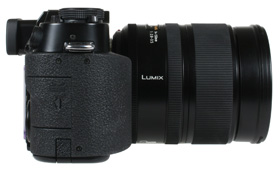Panasonic Lumix DMC-L1
-
-
Written by Gordon Laing
Panasonic Lumix DMC-L1 lens coverage
Panasonic Lumix L1 features continued…
Lenses and viewfinder / Screen and menus / Sensor and processing / Anti dust
The Panasonic Lumix L1 employs a Four Thirds lens mount and is compatible with the existing range from Olympus and Sigma, which at the time of writing totalled 17 and 11 lenses from each manufacturer respectively. Like other Four Thirds DSLRs, the L1’s sensor size effectively reduces the lens field of view by two times, so the Leica 14-50mm kit lens delivers a 35mm equivalent focal length of 28-100mm. The range of the Leica lens in practice is illustrated below and you can read our full report on it in our Leica D 14-50mm review and video tour.
| |
Panasonic Lumix DMC L1 with Leica 14-50mm coverage | ||
 |  | |
| 14-50mm at 14mm, f8 (28mm equivalent) | 14-50mm at 50mm, f8 (100mm equivalent) | |
The Lumix L1 is currently only available as a kit with the Leica zoom, but there’ll be few complaints. This lens is undoubtedly one of the highlights of the entire package, sporting a useful general-purpose range and a bright focal ratio of f2.8-3.5 along with optical stabilisation – not to mention the promise of Leica’s reputation.
 |
|
In practice it performs very well, delivering sharp results across the frame with minimal optical aberrations. The optical stabilisation is also effective and allowed us to easily handhold sharp results at equivalent focal lengths of 100mm using shutters of 1/13 as seen on the Gallery page – this confirms Panasonic’s quoted three stops of compensation.
Complying with the Four Thirds standard, the Leica zoom is also fully compatible with existing Olympus E-Series DSLRs, and there’s certainly been a lot of interest since Panasonic announced it would be available separately. We’ve performed our full suite of tests on the lens and you can read all about it in our Leica D 14-50mm review and video tour.
In the meantime, there are two points worth mentioning. First, like other Four Thirds cameras and lenses, the L1 and Leica zoom employ motor-assisted manual focus. While delivering fine adjustments, many photographers will prefer a true mechanical manual focus. You’ll also need the power-on the camera to manually focus and when you switch the camera off, the lens will reset itself to infinity; fortunately this focus reset doesn’t occur during power save mode though.
Secondly, the L1, like Panasonic’s all-in-ones and compacts, offers two optical image stabilisation (OIS) modes: Mode 1 delivers full-time compensation, while Mode 2 only stabilises when you take the picture but is slightly more effective. These two modes are only supported when you fit the Leica lens on the L1 body though; if you fit the lens to an existing Olympus body, it’ll only offer full-time Mode 1.
Panasonic Lumix DMC-L1 viewfinder
The Lumix L1 is based on the same internal optical path as the earlier Olympus E-330 which allows it to offer composition using the main colour monitor, along with the traditional optical viewfinder. We’ll discuss Panasonic’s implementation of this Live View feature on the next page, and concentrate on the optical viewfinder here.
Like the E-330, the Lumix L1’s viewfinder delivers 95% coverage with a 0.93x magnification. Also like the E-330 though, and indeed other Four Thirds bodies we’ve tested, the actual view itself appears relatively small compared to other digital SLRs. While partly down to the narrower 4:3 aspect ratio of the Four Thirds format, the apparent vertical height of the frame also appears slightly shorter.
Despite the relatively fast focal ratio of the Leica zoom, the viewfinder also appears a little dimmer than most digital SLRs with their kit lenses. This could be due to many factors including the semi-transparent mirror required for one of the E-330’s Live Views, which interestingly is not implemented on the L1.
Either way, the view is smaller and dimmer than most digital SLRs, and can become tricky to use under very dark conditions – for example we struggled to see stars through the L1’s viewfinder which were visible with the Canon EOS 400D / XTi and Nikon D80 even when coupled with their slower kit lenses. To be fair, you do get used to the L1’s viewfinder over time – and it does of course have a unique screen-based alternative for composition – but we’d recommend having a look through it yourself to see if the size and brightness will be an issue. It’s certainly a world apart from the viewfinder experience of, say, the Nikon D80.
While based on the Olympus E-330’s optical system, there are some differences. Both cameras may share the same main view and basic three-point auto-focus system with exposure information running vertically down the right side, but the L1 features a different selection of details. Below the aperture and shutter speed is an exposure compensation scale followed by a number of indicators including bracketing, flash mode and SD activity.
Unlike the E-300, there’s no indication of exposure and metering mode or battery life in the L1’s viewfinder, and neither camera shows the ISO value here either. For all this information on the L1 you’ll need to turn to its main colour screen – an approach with pros and cons which we’ll discuss on the next page.




